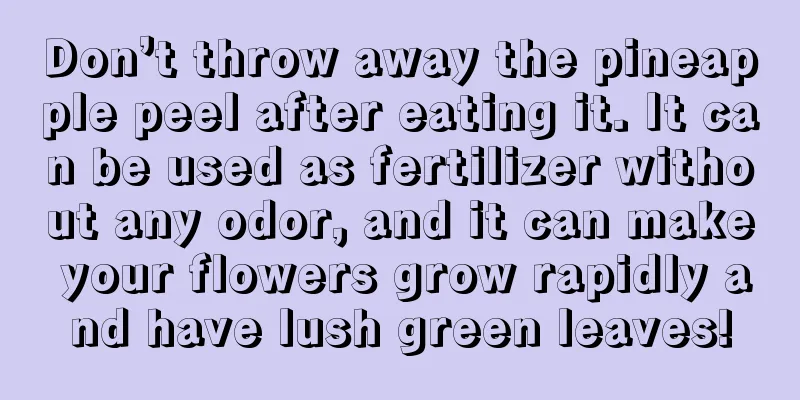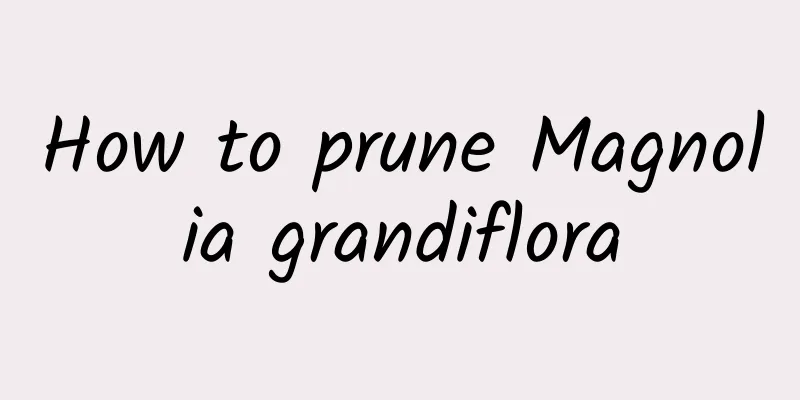Don’t throw away the pineapple peel after eating it. It can be used as fertilizer without any odor, and it can make your flowers grow rapidly and have lush green leaves!

Peeling the pineappleWe usually buy peeled pineapples directly, after all, we don’t have the knife skills of the fruit shop owner. It's okay, just ask the boss to pack up the pineapple skin and take it away. Some flower lovers need to peel the fruit themselves, you can refer to the following method 1. Cut off the head and tail If you are afraid of getting your hands pricked, you can wear gloves. Cut off the head and bottom of the pineapple. The cut pineapple head can also be hydroponically cultivated 2. Cut off the pineapple skin Cut off 3-5 mm of thickness, and then dig out the holes with a horizontal knife. It would be more convenient to have a knife specially made for digging holes. Clean directlyFresh pineapple peel can be used directly to clean kitchen dirt Add some detergent and rub the bottom of the pot. Pineapple is acidic and can remove rust. After wiping, the bottom of the pot will be shiny and bright! Putting pineapple peels in your new home can also remove formaldehyde. Friends who are renovating their homes should collect them quickly~ In addition, the greater use of pineapple peel is: making enzymes Making pineapple peel enzymeFlower lovers must be worried about the strong smell of compost at home. Huahua recommends using pineapple peel to compost. Not only does it have no odor, it is also fragrant and sweet. Let's get started now. 1. Wash and dry the pineapple peel In order to prevent the taste from going bad during fermentation, wash the pineapple skin first. Dry on a sieve 2. Prepare the container and brown sugar Mineral water bottles and glass bottles are both fine. You can choose the size according to your needs and wash the bottles in advance. Let the bottle dry, no raw water in it Prepare brown sugar. The ratio of brown sugar to pineapple peel is 1:3. 3. Add brown sugar water into the container (the ratio of brown sugar to water is 1:10) Be careful not to fill it too full, just fill it about one sixth of the way 4. Add pineapple peel 5. Close the lid 6. Open the lid and release the air every month It usually takes 3 months to mature. During the fermentation period, some gas will be produced, so be careful to release the gas. If you find it troublesome, you can tie a rubber glove to the mouth of the bottle. When there is too much gas, the glove will be "filled up". At this time, you can quickly open it to let in air. Generally, you only need to open it 1-2 times a month. The following is the first month of opening the lid. It has a sweet and sour fruity aroma. It is normal to have some foam O(∩_∩)O Some flower lovers may find a white film on the surface of the enzyme, which is normal and not bad. 7. Filter and set aside After 3 months, the enzyme is ready. Let's use gauze as a filter to filter it. After filtering, put it into small bottles 8. Add water to water the flowers Pineapple peel enzyme cannot be used directly to water flowers. It must be diluted with clean water (enzyme: water = 1:1000). You don’t need to water it frequently, just water it twice a month. It guarantees that your flowers will grow bigger and bigger and the leaves will be lush green! 9. Used as a cleaning agent Pineapple peel, detergent and water (1:1:10) can be made into a strong cleaning agent with strong cleaning power and natural fruit fragrance. Can clean greasy dirt such as kitchen sinks and countertops Used to mop the floor, scrub the leather sofa, and glass tabletop to make them fresh and clean It can also be used to clean bathroom tiles, water tables, etc. Are other fruit peels universal?In addition to pineapple peel, apple peel, grapefruit peel, tangerine peel, and orange peel can also be used. The left side of the picture below shows apple enzyme, and the right side shows orange peel enzyme. The enzyme has a fruity aroma, which is really mouth-watering. You can use the fruit pulp to make enzymes and eat them! The picture below shows fruit enzymes made with pineapple flesh, lemon and rock sugar. The picture below shows pineapple, papaya, kiwi, lemon and brown sugar as fruit enzymes. After it is done, filter it and put it into the bottle. It is beautiful, natural juice enzyme~ Can be drunk as tea It can be added to water, yogurt, or milkshakes. The fruit flavor is even more delicious! Having said so much Have you learned it? Next time you eat pineapple Try it now! |
<<: What to do if gardenia leaves have black spots
>>: What to do if the leaves of green radish curl up
Recommend
Grape planting methods and management techniques
As a fruit with significant economic benefits and...
When do lilacs bloom?
Flowering period The flowering time of lilac vari...
The application value of morning glory
The ornamental value of morning glory The leaves ...
How to prune strawberry seedlings
When to prune strawberry seedlings During the gro...
Why can't we plant yellow poplar trees at home? What are the taboos of planting yellow poplar trees?
You can plant yellow horn trees at home. The yell...
Plants suitable for the bedroom, flowers suitable for the bedroom
1. Christmas cactus This is a very easy-to-grow f...
How to grow a lucky tree so that it will flourish
1. Environment If you want to grow a plant well, ...
Can plum blossoms be planted in the yard?
Can plum blossoms be planted in the yard? Plum bl...
The efficacy and function of Yushu
1. Ornamental effect Its crown is very tall and b...
What to do if the leaves of Fraxinus chinensis turn yellow
1. Careful maintenance Cause: It may just be norm...
How to make succulent leaves take root and sprout quickly (how to make succulent petals fall off and take root)
Succulent leaves taking root The biggest worry wh...
How to grow the Welcoming Pine to make it grow vigorously?
The Welcoming Pine has the profound meaning of sy...
How to plant and care for lilies
Growth environment Growth habit Lily is a cool-lo...
How to eat mango
1. Direct consumption 1. Wash the mango with wate...
How to eat aloe vera
Can aloe vera be eaten? Benefits of eating aloe v...









